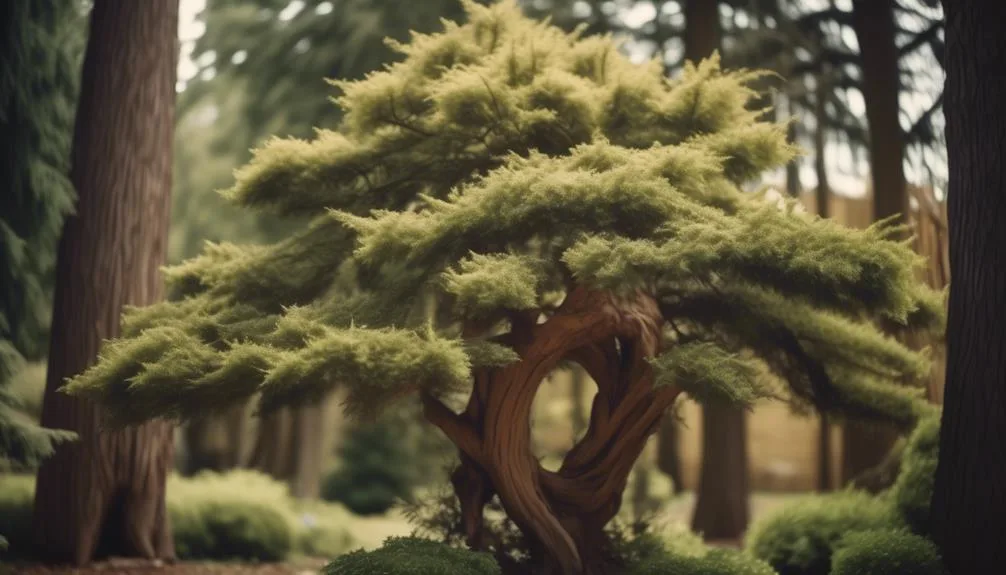Is your cedar tree not growing as expected? Several factors could be hindering its growth. Understanding these reasons is crucial to help your tree thrive.
Let's explore the different elements that affect your cedar tree's development. By identifying the issues, you can take the necessary steps to support its growth.
Understanding Cedar Tree Growth Factors
To ensure healthy growth of your cedar tree, understanding the key factors affecting its development is crucial.
Proper pruning methods play a significant role in promoting the growth of your cedar tree. Regular pruning helps maintain the tree's shape, removes dead or diseased branches, and encourages new growth. It's essential to prune during the dormant season to minimize stress on the tree.
Additionally, implementing a well-planned fertilization schedule is vital for the optimal growth of your cedar tree. By providing the right nutrients at the right time, you can ensure that your tree has the resources it needs to thrive. Understanding the specific fertilization needs of cedar trees, such as nitrogen, phosphorus, and potassium, will help you create a schedule that supports healthy growth and development.
Assessing Soil Quality and Composition
Assessing the quality and composition of your soil is crucial for understanding the specific needs of your cedar tree and ensuring its healthy growth and development. Soil testing can reveal important information about nutrient deficiency, pH levels, and overall soil health.
By understanding the results of a soil test, you can make informed decisions about the types and amounts of fertilizers or soil amendments needed to improve the soil quality for your cedar tree. Additionally, improving drainage might be necessary if your soil is too compacted, as waterlogged soil can lead to stunted growth.
Checking the pH levels of your soil is also essential, as cedar trees thrive in slightly acidic soil. Making adjustments to the soil composition based on these assessments can greatly benefit the overall health and growth of your cedar tree.
Optimizing Sunlight and Shade Conditions
Understanding the optimal sunlight and shade conditions for your cedar tree is essential for promoting healthy growth and ensuring its overall well-being. Maximizing photosynthesis through proper sunlight exposure is crucial for the tree's development.
Here are some tips to optimize sunlight and shade conditions for your cedar tree:
- Location: Choose a planting location that provides full sun or partial shade, depending on the specific cedar tree species.
- Pruning Techniques: Regularly prune surrounding vegetation to ensure the cedar tree receives adequate sunlight without being overly shaded by other plants.
- Timing: Be mindful of the seasonal changes in sunlight angles and adjust the tree's surroundings if necessary to maintain optimal light exposure throughout the year.
Implementing Proper Watering Techniques
Properly watering your cedar tree is crucial for its growth and overall health, and it requires a thoughtful approach to ensure it receives the right amount of moisture. Proper hydration is essential for the root development of your cedar tree. Here are some essential tips for watering your cedar tree effectively:
| Watering Tips | Description | Frequency |
|---|---|---|
| Water deeply | Ensure water reaches the root zone | Every 1-2 weeks |
| Mulch | Helps retain moisture and regulate soil temperature | As needed |
| Avoid overwatering | Prevents waterlogged soil and root rot | Only when necessary |
Managing Pest Infestations and Diseases
To ensure the health and vitality of your cedar tree, it's essential to be proactive in managing pest infestations and diseases. Implementing effective pest control and disease prevention measures can protect your tree from potential harm. Here are some key strategies to consider:
- Regularly inspect your cedar tree for signs of pest infestations or diseases, such as unusual discoloration, wilting, or abnormal growth.
- Utilize natural predators or organic pesticides to control insect infestations without harming beneficial organisms or the environment.
- Prune and remove any infected or diseased branches to prevent the spread of diseases and promote the tree's overall health.
Conclusion
In summary, nurturing your cedar tree's growth involves tending to soil quality, sunlight exposure, watering, and pest control. By optimizing these factors, you can create an environment for your cedar tree to thrive.
Monitoring and adjusting these elements will ensure your cedar tree reaches its full potential.
How will you cultivate the ideal conditions for your cedar tree's vitality?

My interest in trees started when I first saw the giant sequoias in Yosemite.
I was a teenager then, and I remember thinking, “I need to learn more about this.”
That moment stuck with me.
A few years later, I went on to study forestry at Michigan Tech.
Since graduating, I’ve worked in a mix of hands-on tree care and community education.
I’ve spent over ten years helping people understand how to plant, maintain, and protect the trees in their neighborhoods.
I don’t see trees as just part of the landscape.
They are living things that make a real difference in our daily lives.
